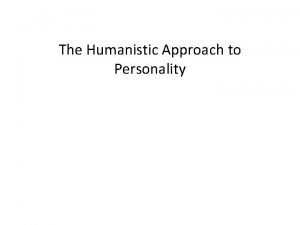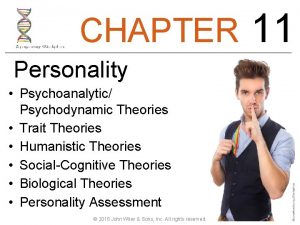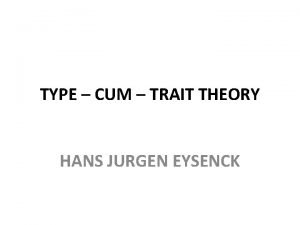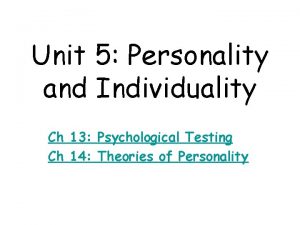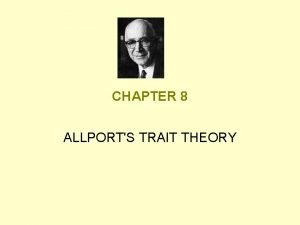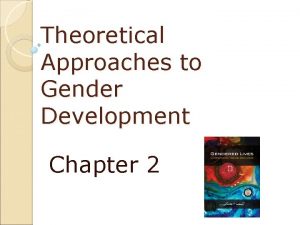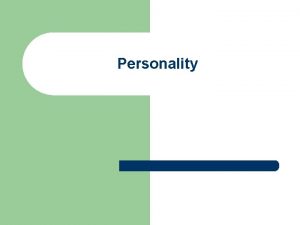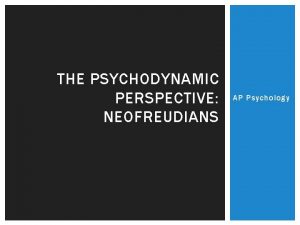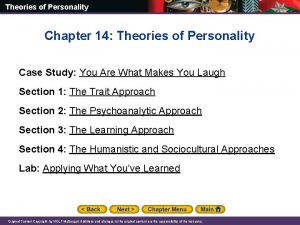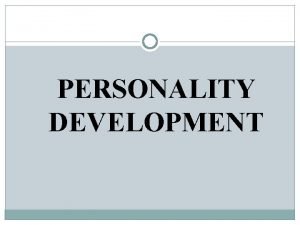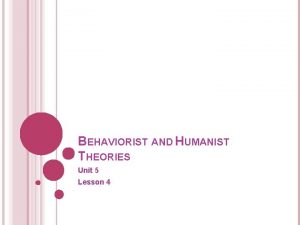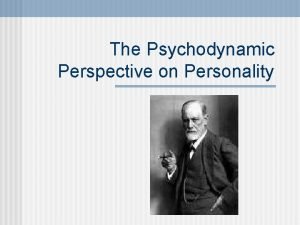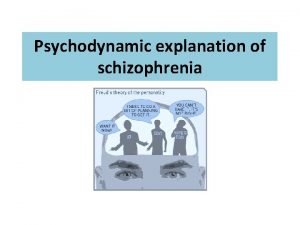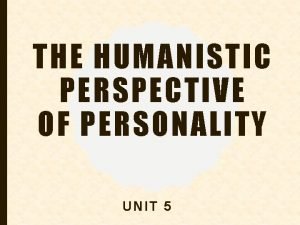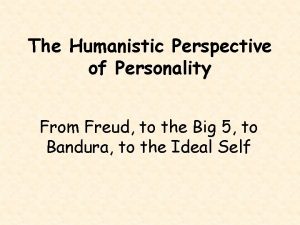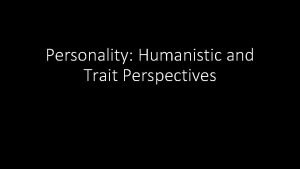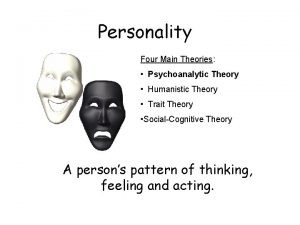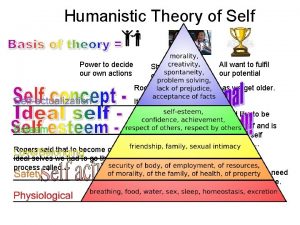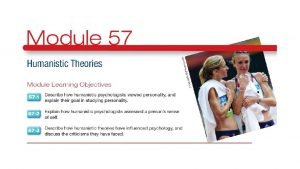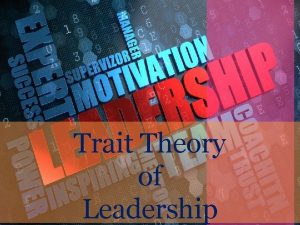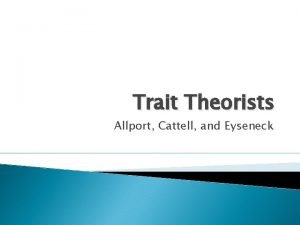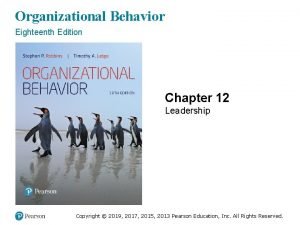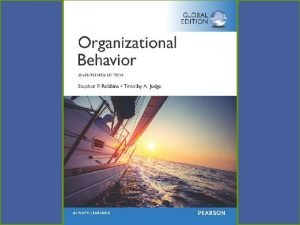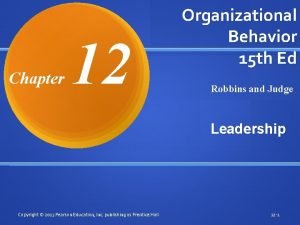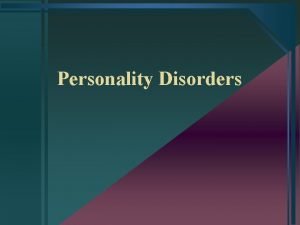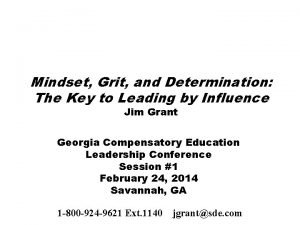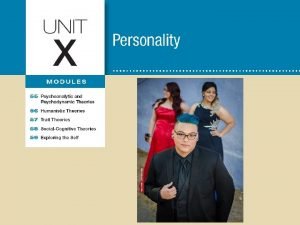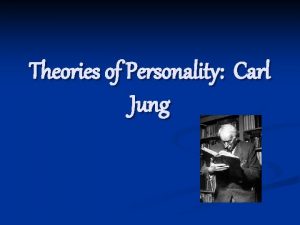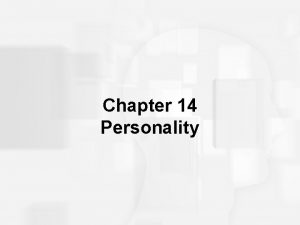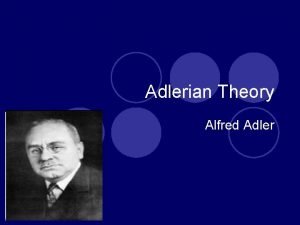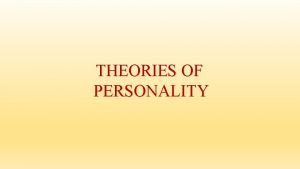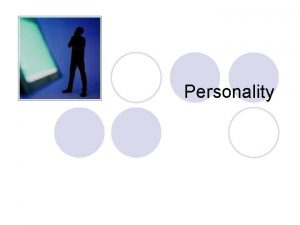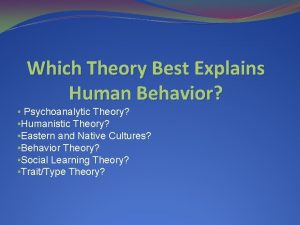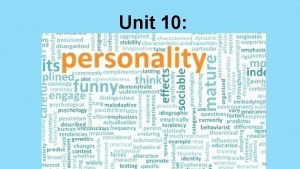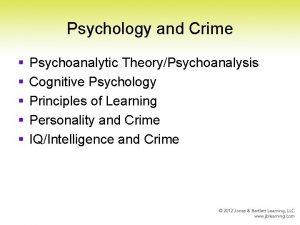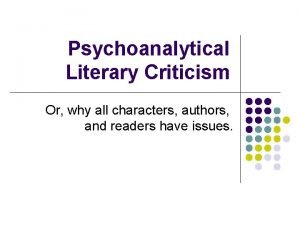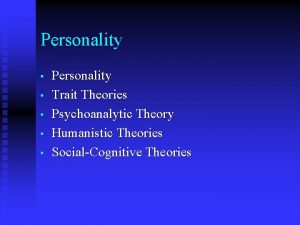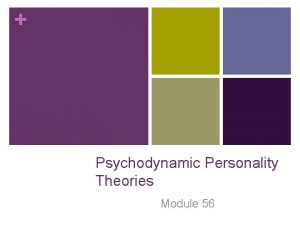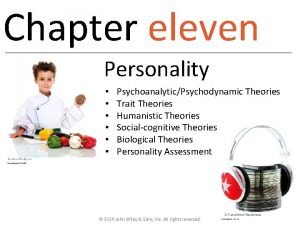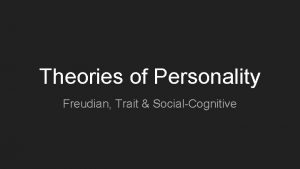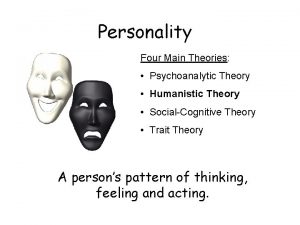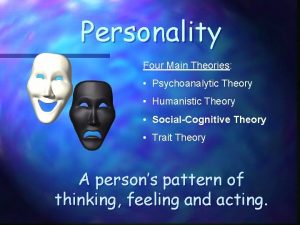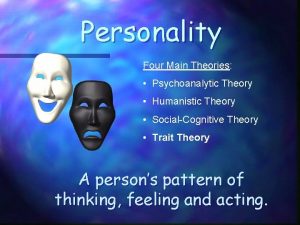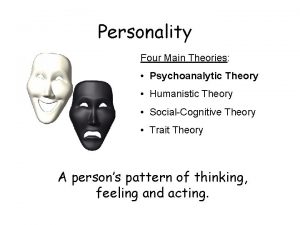CHAPTER Personality Psychoanalytic Psychodynamic Theories Trait Theories Humanistic




















































- Slides: 52

CHAPTER Personality • Psychoanalytic/ Psychodynamic Theories • Trait Theories • Humanistic Theories • Social-Cognitive Theories • Biological Theories • Personality Assessment © 2016 John Wiley & Sons, Inc. All rights reserved. 11

Real World Psychology Things you’ll learn in Chapter 11 Q 1 Are some people with highly negative attitudes toward gay people repressing their own sexual desires? Q 2 Which personality traits are most important for your career and academic success? Q 3 What parenting skills are also associated with increased marital satisfaction? Q 4 Can spending time in a foreign country change your personality? Q 5 Do our genes predict how much we will give to charity? Q 6 Can social media postings be used to measure your personality? © 2016 John Wiley & Sons, Inc. All rights reserved.

Personality • “Our unique and relatively stable pattern of thoughts, feelings and actions” • Various theories – Psychoanalytic / Psychodynamic – Trait – Humanistic – Social / Cognitive – Biological • Also assessed & measured in various ways © 2016 John Wiley & Sons, Inc. All rights reserved.

Psychoanalytic/Psychodynamic Theories Freud’s Psychoanalytic Theory • Levels of consciousness – Conscious – Preconscious – Unconscious • Three mental structures – Id – Ego – Superego © 2016 John Wiley & Sons, Inc. All rights reserved.

Psychoanalytic/Psychodynamic Theories Freud’s Psychoanalytic Theory (continued) Freud’s three levels of consciousness FIGURE 11. 1 - The tip of the iceberg would be analogous to the conscious mind, which is above the water and open for easy inspection - The preconscious mind (the area only shallowly submerged) contains information that can be viewed with a little extra effort - The large base of the iceberg is somewhat like the unconscious, completely hidden from personal inspection © 2016 John Wiley & Sons, Inc. All rights reserved.

Psychoanalytic/Psychodynamic Theories Freud’s Psychoanalytic Theory (continued) Freud’s personality structures • ID (pleasure principle) • Ego (reality principle) • Superego (the conscience) Note how the ego is primarily conscious whereas the id is entirely unconscious © 2016 John Wiley & Sons, Inc. All rights reserved. FIGURE 11. 3

Psychoanalytic/Psychodynamic Theories Freud’s Psychoanalytic Theory (continued) • Defense mechanisms – How the ego reduces anxiety through selfdeception and distorting reality • Psychosexual stages – Five developmental periods, each with a particular kind of pleasure must be gratified for personality to develop normally – If a need isn’t met at any stage, one could become fixated in his/her development © 2016 John Wiley & Sons, Inc. All rights reserved.

Psychoanalytic/Psychodynamic Theories Freud’s Psychoanalytic Theory (continued) Defense mechanisms FIGURE 11. 4 Defense mechanisms can be healthy and helpful if we use them in moderation or on a temporary basis © 2016 John Wiley & Sons, Inc. All rights reserved.

Psychoanalytic/Psychodynamic Theories Freud’s Psychoanalytic Theory (continued) DEFENSE MECHANISM Repression DESCRIPTION Sublimation Redirecting socially unacceptable impulses into acceptable activities (e. g. redirecting aggressive impulses by becoming a professional fighter) Denial Refusing to accept an unpleasant reality (e. g. Alcoholics refusing to admit their addiction) Preventing painful or unacceptable thoughts from entering consciousness (e. g. forgetting the details of a traffic accident) © 2016 John Wiley & Sons, Inc. All rights reserved. TABLE 11. 1 a

Psychoanalytic/Psychodynamic Theories Freud’s Psychoanalytic Theory (continued) DEFENSE DESCRIPTION MECHANISM Creating a socially acceptable excuse to justify Rationaliunacceptable behavior (e. g. Justifying cheating on zation an exam by saying “everyone else does it”) Intellectualization Projection © 2016 John Wiley & Sons, Inc. All rights reserved. Ignoring the emotional aspects of a painful experience by focusing on abstract thoughts, words or ideas (e. g. Discussing your divorce without emotion by ignoring the hidden, underlying pain) Transferring unacceptable thoughts, motives or impulses to others (e. g. Becoming unreasonably jealous of your mate while denying your attraction to others) TABLE 11. 1 b

Psychoanalytic/Psychodynamic Theories Freud’s Psychoanalytic Theory (continued) DEFENSE DESCRIPTION MECHANISM Not acknowledging unacceptable impulses and Reaction overemphasizing the opposite (e. g. Promoting a formation petition against adult bookstores even though you are secretly fascinated by pornography) Regression Displacement © 2016 John Wiley & Sons, Inc. All rights reserved. Reverting to immature ways of responding (e. g. Throwing a temper tantrum when a friend doesn’t want to do what you’d like) Redirecting impulses from the original source toward a less threatening person or object (e. g. Yelling at a coworker after being criticized by your boss) TABLE

Psychoanalytic/Psychodynamic Theories Freud’s Psychoanalytic Theory (continued) Freud’s Five Psychosexual Stages Oral (0 -18 mos. ) – Mouth (Weaning from breast or bottle) Anal (18 mos. -3 yrs. ) – Anus (Toilet training) Phallic (3 -6 yrs. ) – Genitals (Overcoming Oedipus complex by identifying with same-sex parent) Latency (6 yrs. -puberty) – None (Interacting with same-sex peers) Genital (puberty-adult) – Genitals (Establishing intimate relationships with the opposite sex) PROCESS DIAGRAM 11. 1 © 2016 John Wiley & Sons, Inc. All rights reserved.

Psychoanalytic/Psychodynamic Theories Psychodynamic/Neo-Freudian Theories • Alfred Adler – Behavior is purposeful and goal-directed – Inferiority complex • Carl Jung – Personal vs. collective unconscious – Archetypes • Karen Horney FIGURE 11. 6 – Adult personalities are shaped by childhood relationships with parents – Basic anxiety © 2016 John Wiley & Sons, Inc. All rights reserved.

Psychoanalytic/Psychodynamic Theories Evaluating Psychoanalytic Theories • Major criticisms of Freud – Inadequate empirical support • Many concepts can’t be scientifically tested – Overemphasis on various things • Sexuality • Biology • Unconscious forces FIGURE 11. 7 – Corresponding reduced focus on other things • Learning • Culture – Sexism and derogatory view of women © 2016 John Wiley & Sons, Inc. All rights reserved.

Q 1 Are some people with highly negative attitudes toward gay people repressing their own sexual desires? • People who identify as having a heterosexual orientation but show a strong sexual attraction to same-sex people in psychological tests tend to have more sexual prejudice and higher levels of hostility toward gay people. (Weinstein et al. , 2012) © 2016 John Wiley & Sons, Inc. All rights reserved.

Trait Theories Early Trait Theories • Trait defined • Allport – trait hierarchy • Cattell – 16 source traits • Eysenck – 3 basic types of traits – Extraversion-introversion – Neuroticism – Psychoticism © 2016 John Wiley & Sons, Inc. All rights reserved.

Trait Theories Early Trait Theories (continued) Cattell’s 16 Source Traits © 2016 John Wiley & Sons, Inc. All rights reserved.

Trait Theories Modern Trait Theory • The five-factor model (FFM) – Includes five basic dimensions • • • Openness Conscientiousness Extraversion Agreeableness Neuroticism – Informally referred to as Big Five” Note that the first letter of these five dimensions forms the acronym O-C-E -A-N “The © 2016 John Wiley & Sons, Inc. All rights reserved.

Trait Theories Modern Trait Theory The five-factor model (FFM) Each of the five factors exist on a continuum (from low to high) Do you think these five factors accurately reflect your key personality traits? FIGURE 11. 8 © 2016 John Wiley & Sons, Inc. All rights reserved.

Q 2 Which personality traits are most important for your career and academic success? • Conscientiousness, agreeableness and openness are reliable predictors for success. • Conscientiousness is most strongly linked with academic grade point average (GPA), especially in subjects that students generally find uninteresting. (Dumfart & Neubauer, 2016; Rahafar et al. , 2016; Vecchione et al. , 2016) © 2016 John Wiley & Sons, Inc. All rights reserved.

Trait Theories Evaluating Trait Theories • Wide-ranging support exists for the FFM – Demonstrates a high degree of shared preferences for certain traits – Strong cross-cultural support – Allows for the prediction of real-life preferences and behaviors • Criticisms of the FFM – Fails to consider situational determinants – Offers insufficient explanation for why people develop specific traits © 2016 John Wiley & Sons, Inc. All rights reserved.

Trait Theories Evaluating Trait Theories (continued) Mate Preferences and the Five-Factor Model WHAT MEN MOST WANT IN A MATE 1. Mutual attraction – love 6. Education & intelligence 2. Dependable character 7. Sociability 3. Emotional stability & maturity 8. Desire for home & children 4. Pleasing disposition 9. Refinement, neatness 5. Good health 10. Good looks (*) * - Not on women’s top 10 © 2016 John Wiley & Sons, Inc. All rights reserved. TABLE 11. 2 a

Trait Theories Evaluating Trait Theories (continued) Mate Preferences and the Five-Factor Model WHAT WOMEN MOST WANT IN A MATE 1. Mutual attraction – love 6. Sociability (7) 2. Dependable character 7. Good health (5) 3. Emotional stability & maturity 8. Desire for home & children 4. Pleasing disposition 9. Ambition & industriousness (-) 5. Education & intelligence (6) 10. Refinement, neatness (9) - - Not on men’s top 10 # - Ranking on men’s top 10 © 2016 John Wiley & Sons, Inc. All rights reserved. TABLE 11. 2 b

Humanistic Theories Roger’s Theory • Self concept – The way we see and feel about ourselves – The most important component of personality • Unconditional positive regard – Love and acceptance with ‘no strings attached’ – Such an atmosphere is essential to help children develop to their fullest potential © 2016 John Wiley & Sons, Inc. All rights reserved.

Humanistic Theories Roger’s Theory (continued) According to Rogers, in order to be regarded as a welladjusted individual, there needs to be a great deal of overlap (congruence) between one’s real and ideal selves. According to Rogers, poor mental health and personality maladjustment result when there is an incongruence – or mismatch – between our ideal and real selves. © 2016 John Wiley & Sons, Inc. All rights reserved.

Q 3 What parenting skills are also associated with increased marital satisfaction? • Interestingly, parents who in responsive caregiving also tend to show this same pattern of behavior (unconditional regard) toward their spouses, which in turn leads to higher levels of relationship satisfaction. (Millings et al. , 2013) • This suggests that unconditional positive regard is important in types of relationships. © 2016 John Wiley & Sons, Inc. All rights reserved. all

Humanistic Theories Maslow’s Theory • We have a basic human tendency to pursue self-actualization (an inborn drive to develop our talents and capacities) • Personality development results from the natural progression of seeking to meet higher and higher levels of needs • Only a few, rare individuals ever become fully self-actualized (e. g. Einstein, Gandhi) © 2016 John Wiley & Sons, Inc. All rights reserved.

Humanistic Theories Maslow’s Theory (continued) Maslow’s Hierarchy of Needs Although the natural progression is upward, regression toward a lower level can occur – especially under stressful conditions – such as during natural disasters or a period of unemployment. FIGURE 11. 10 © 2016 John Wiley & Sons, Inc. All rights reserved.

Humanistic Theories Evaluating Humanistic Theories • Lasting impacts - Valuable insights useful for personal growth and self-understanding - Strong impact in the areas of contemporary counseling and psychotherapy, childrearing, education and managerial practices • Criticized in areas of naïve assumptions, poor testability, inadequate evidence and narrowness of focus © 2016 John Wiley & Sons, Inc. All rights reserved.

Social-Cognitive Theories Bandura and Rotter • Albert Bandura - Self-efficacy (his term for self-confidence) - Reciprocal determinism – the interplay of: • • • Internal personal factors Environment Behavior • Julian Rotter - Your behavior and personality are determined by: • • What you expect to happen following an action The reinforcement value attached to specific outcomes © 2016 John Wiley & Sons, Inc. All rights reserved.

Social-Cognitive Theories Bandura (continued) Bandura’s theory of reciprocal determinism FIGURE 11. 11 © 2016 John Wiley & Sons, Inc. All rights reserved. According to Bandura, personality is determined by a three-way, reciprocal interaction of the internal characteristics of a person, the external environment and the person’s behavior.

Social-Cognitive Theories Evaluating Social-Cognitive Theories • Contributions - Offer testable, objective hypotheses Provide operationally defined terms Reliance on empirical data Believe that both personality and situations predict behavior in real-world situations • Criticisms - Too great of a focus on situational influences Doesn’t adequately acknowledge the stability of personality or sociocultural, emotional and biological influences © 2016 John Wiley & Sons, Inc. All rights reserved.

Q 4 Can spending time in a foreign country change your personality? • High school students who study abroad (thereby experiencing a change in environment) show greater changes in personality than those who do not. (Hutteman et al. , 2015) • Exchange students showed substantial increases in their self-esteem compared to those who stayed home. © 2016 John Wiley & Sons, Inc. All rights reserved.

Biological Theories 3 Major Contributors to Personality • The Biological Bases of Personality (Eysenck) 1. Brain structures that correlate with particular traits • Impulsiveness • Risk-aversive vs. risk-seeking 2. Neurochemistry • Sensation-seeking is linked to MAO levels of • Novelty-seeking/extraversion is linked to dopamine © 2016 John Wiley & Sons, Inc. All rights reserved.

Biological Theories 3 Major Contributors to Personality (continued) • The Biological Bases of Personality (continued) 3. Genetics • • • Behavioral genetics Studies of identical and fraternal twins suggested that about 40 -50% of our personality traits are genetic Studies of parents and their biological and adopted children showed that parents’ traits correlated moderately to their biological children and hardly at all to their adopted children © 2016 John Wiley & Sons, Inc. All rights reserved.

Q 5 Do our genes predict how much we will give to charity? • One study found that individuals with a “niceness gene” were more likely to report engaging in various types of prosocial behaviors, such as: - giving blood - volunteering - donating to charitable (Poulin et al. , 2012) © 2016 John Wiley & Sons, Inc. All rights reserved. organizations

Biological Theories 3 Major Contributors to Personality (continued) Identical versus fraternal twins • 100% shared genes • Share the same placenta • Are always the same sex FIGURE 11. 13 © 2016 John Wiley & Sons, Inc. All rights reserved. • Around 50% shared genes • No more genetically similar than non-twin siblings • Share environment in the womb (“womb mates”)

Biological Theories 3 Major Contributors to Personality (continued) Adoption Studies © 2016 John Wiley & Sons, Inc. All rights reserved. FIGURE 11. 14

Biological Theories Evaluating Biological Theories Benefits Drawbacks • Exciting insights with clear links between some traits and various brain areas, neurotransmitters and/or genes • Recognition that traits are never the result of a single biological process • Potential to overemphasize genetics • The role of the unshared environment – even in the same family – has been overlooked © 2016 John Wiley & Sons, Inc. All rights reserved.

Biological Theories Evaluating Biological Theories (continued) What factors help to contribute to this girl being shy? Multiple influences on personality • 40 -50% Genetics • 27% Nonshared environment • 7% Shared environment • 16 -26% Unknown © 2016 John Wiley & Sons, Inc. All rights reserved. FIGURE 11. 15

Personality Assessment Interviews and Observation • Interviews • Observation - Unstructured • Permit greater free exploration of personality - Direct - Methodical - Structured Specific questions asked Allow objective evaluation of responses and comparison to others © 2016 John Wiley & Sons, Inc. All rights reserved. FIGURE 11. 17

Personality Assessment Interviews and Observation (continued) Facebook test of your personality FIGURE 11. 18 © 2016 John Wiley & Sons, Inc. All rights reserved.

Q 6 Can social media postings be used to measure your personality? • An examination of Facebook likes can accurately predict a number of traits and attributes, including: - sexual orientation - ethnicity - religious beliefs - political views - personality intelligence happiness use of addictive substances © 2016 John Wiley & Sons, Inc. All rights reserved. - parental separation - age - gender (Kosinski et al. , 2013)

Personality Assessment Objective Tests • Standardized tests • Examples – The Minnesota Multiphasic Personality Inventory (MMPI) • Most widely used and researched; self-report • Mainly used to diagnose psychological disorders – The NEO Personality Inventory • Assesses using the five-factor model © 2016 John Wiley & Sons, Inc. All rights reserved.

Personality Assessment Objective Tests (continued) Entrepreneurship in the United States Does the higher measure of “entrepreneurial spirit” in the Western U. S. reflect America’s historical migration patterns of people moving from the East to the West? © 2016 John Wiley & Sons, Inc. All rights reserved.

Personality Assessment Projective Tests • Subject is presented with a standardized set of ambiguous stimuli – The responses are assumed to reveal inner feelings, motives and conflicts • Examples – The Rorschach Inkblot Test – The Murray Thematic Apperception Test (TAT) © 2016 John Wiley & Sons, Inc. All rights reserved.

Personality Assessment Projective Tests (continued) Sample Projective Tests The Rorschach Inkblot Test Thematic Apperception Test © 2016 John Wiley & Sons, Inc. All rights reserved.

Personality Assessment Evaluating Personality Assessments • Interviews and Observation - Benefits • Potential for a wide array of data - Drawbacks • Quite costly • Very time consuming • Little agreement on interpretation © 2016 John Wiley & Sons, Inc. All rights reserved.

Personality Assessment Evaluating Personality Assessments (continued) • Objective Tests – Benefits • Can be administered to a large number of people • Standard assessment – allows for comparisons – Drawbacks • Deliberate deception and social desirability bias • Diagnostic difficulties • Cultural bias and inappropriate use © 2016 John Wiley & Sons, Inc. All rights reserved.

Personality Assessment Evaluating Personality Assessments (continued) • Projective Tests – Benefit • Believed to serve as a “psychological X-ray” when respondents may be unable or unwilling to express their true feelings – Drawbacks • Extremely time-consuming to administer and interpret • Low reliability and validity © 2016 John Wiley & Sons, Inc. All rights reserved.

Personality Assessment Evaluating Personality Assessments (continued) Summary Cautions • Each type of test has its limits; hence, psychologists typically combine the results of various scientific methods to create a fuller picture of an individual’s personality • Beware of pseudopersonality quizzes • Employ common logical fallacies: – Barnum effect – Confirmation bias – Self-serving biases Critical thinking is important when evaluating personality tests © 2016 John Wiley & Sons, Inc. All rights reserved.

© 2016 John Wiley & Sons, Inc. All rights reserved.
 Freud fixations
Freud fixations Humanistic approach to personality
Humanistic approach to personality Difference between psychoanalysis and psychodynamic
Difference between psychoanalysis and psychodynamic Freud's five stages of psychosexual development
Freud's five stages of psychosexual development Type and trait theories of personality
Type and trait theories of personality Trait theories of personality _____.
Trait theories of personality _____. Psychodynamic and humanistic therapies have in common
Psychodynamic and humanistic therapies have in common Humanistic therapy aims to
Humanistic therapy aims to Difference between humanistic and trait theory
Difference between humanistic and trait theory Humanistic traits
Humanistic traits Psychodynamic theories definition
Psychodynamic theories definition Psychodynamic theories definition
Psychodynamic theories definition Psychodynamic ap psychology
Psychodynamic ap psychology Chapter 14 theories of personality
Chapter 14 theories of personality Sigmund freud psychodynamic theory
Sigmund freud psychodynamic theory Psychoanalysis psychology example
Psychoanalysis psychology example What does the psychoanalytic approach to personality teach?
What does the psychoanalytic approach to personality teach? Social cognitive approaches to personality
Social cognitive approaches to personality Chapter 3 applying learning theories to healthcare practice
Chapter 3 applying learning theories to healthcare practice Behaviorist vs humanist
Behaviorist vs humanist Psychodynamic perspective definition psychology
Psychodynamic perspective definition psychology Tripartite structure of personality
Tripartite structure of personality Psychodynamic approach to personality
Psychodynamic approach to personality Abraham maslow developed his hierarchy of needs
Abraham maslow developed his hierarchy of needs Humanistic perspective
Humanistic perspective Humanistic perspective
Humanistic perspective Sublimation psychology
Sublimation psychology Humanistic psychology
Humanistic psychology Humanistic psychologists may assess personality by
Humanistic psychologists may assess personality by Traits theory of leadership
Traits theory of leadership Trait theory of personality
Trait theory of personality Social cognitive personality
Social cognitive personality Organizational behavior chapter 12
Organizational behavior chapter 12 Summarize the conclusions of trait theories of leadership.
Summarize the conclusions of trait theories of leadership. Summarize the conclusions of trait theories of leadership.
Summarize the conclusions of trait theories of leadership. Latent trait theory
Latent trait theory Personality trait disorder
Personality trait disorder Mc trait
Mc trait Personality definition psychology
Personality definition psychology Trait theory
Trait theory Openness personality trait
Openness personality trait Grit personality trait
Grit personality trait What is a personality trait
What is a personality trait According to jung the unconscious mind is characterized by
According to jung the unconscious mind is characterized by Freudian personality test
Freudian personality test Compliant personality definition
Compliant personality definition Alfred adler theory of personality
Alfred adler theory of personality Personality in psychology
Personality in psychology L
L Psychoanalytic theory
Psychoanalytic theory Freudian fixation
Freudian fixation Psychoanalytic theory criminology
Psychoanalytic theory criminology Sexlll
Sexlll

